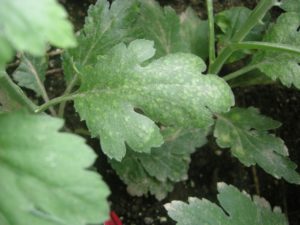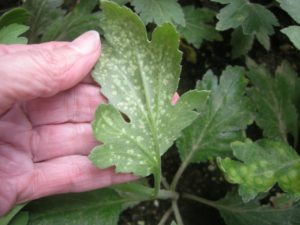Chrysanthemum White Rust: Good Management Prevents Major Losses
by Elizabeth Lamb, Margery Daughtrey, Margaret Kelly
Chrysanthemum white rust (CWR) is a fungal disease of chrysanthemums caused by Pucciniahoriana that can cause severe damage, including complete crop loss due to direct effects of the disease or to quarantine procedures. Pot mums, garden mums and mums grown for cut flowers are all susceptible to the disease. The characteristic symptoms are small white to yellow spots on the upper leaf surface corresponding to pinkish to white pustules on the lower leaf surface. Early infestations may be hard to identify. Train workers how to identify CWR so that any outbreaks can be identified early before they spread through the crop. The disease is very contagious within a mum planting, and can be spread to other plantings by the wind during rainy weather.
For more information on identifying and preventing chrysanthemum white rust, additional references are available.

Preventative treatments for CWR that are labeled in NY
Prevention is the best method of control. Buy cuttings from a reliable source. Inspect them when they come in and regularly thereafter for symptoms of white rust. Water with drip tapes or individual emitters if possible to avoid splashing spread via overhead irrigation. Do not keep any decorative plantings of chrysanthemum on your property from year to year.
Infected plants may not show symptoms until the plants are in the proper environment. Cool weather (40-73 F), high humidity (over 75%) and wet foliage for at least 5 hours promote the development of CWR. If temperatures stay above 73 F and no rainfall is predicted, no treatment is necessary. If rainfall is predicted for a 24-hour or longer period and the temperatures are expected to be near or below 73 F, preventative fungicide treatment is prudent even on crops that appear healthy.
Many weather websites provide temperature and precipitation forecasts based on your zipcode or a nearby airport.
When using rust fungicides preventively, rotate among active ingredients and FRAC codes. Use contact (e.g. chlorothalonil and mancozeb) as well as systemic (strobilurin and DMI) materials within the rotation. Follow all label precautions regarding whether treatments are recommended for plants in flower.
For additional information on fungicides for rust management, check the Cornell Guide for the Integrated Management of Greenhouse Floral Crops or the Cornell Pest management Guide for the Production ad Maintenance of Herbaceous Perennials.
Remember to check the label for specifics of use.
Because chrysanthemum white rust is a Federally regulated pest, you must contact your NYS Horticulture Inspector if you suspect your plants are infected. For contact information for your local inspector, call the Division of Plant Industry at 518 457-2087.





